Structured Products
In a rapidly changing market, our Structured Products offer flexible, market-linked investments for reliable performance. Designed to meet evolving investor needs, our notes focus on outcomes, providing options for capital protection, diversification, or growth. Access local and global opportunities with risk management tailored to your goals.
Benefits of Structured Products
Tailored strategies
Client focused
Multi-asset class exposure
Thematic and purpose-led
Types of Structures
We offer a suite of structured solutions designed to adapt to the market and to you and are thematic in nature.
JSE Top 40 monthly issuances, issued under the R150bn Standard Bank Structured Note Program listed on the JSE, these structured notes offer transparent, listed exposure to South Africa’s largest and most liquid entities.
- Capital efficient
- Backed by our strong balance sheet
- Suitable for individual and advised clients
For more information, speak to your financial advisor or contact our Retail Structuring Client Relations Teams at [email protected].
Designed around macro trends and global themes such as AI and environment, social and governance (ESG) and responsive to current market trends, these products are transparent, listed and backed by a strong balance sheet, giving you peace of mind.
Our quarterly thematic issuances form part of our inward listed programme, giving you access to global financial markets without the need to externalise your currency.
- Why choose these notes:
- For trend-conscious investors
- Diversified and purpose-built
- Opportunity for higher performance with clear parameters
Explore current themes here.
-
Monthly notes
-
Quarterly thematic notes
JSE Top 40 monthly issuances, issued under the R150bn Standard Bank Structured Note Program listed on the JSE, these structured notes offer transparent, listed exposure to South Africa’s largest and most liquid entities.
- Capital efficient
- Backed by our strong balance sheet
- Suitable for individual and advised clients
For more information, speak to your financial advisor or contact our Retail Structuring Client Relations Teams at [email protected].
Designed around macro trends and global themes such as AI and environment, social and governance (ESG) and responsive to current market trends, these products are transparent, listed and backed by a strong balance sheet, giving you peace of mind.
Our quarterly thematic issuances form part of our inward listed programme, giving you access to global financial markets without the need to externalise your currency.
- Why choose these notes:
- For trend-conscious investors
- Diversified and purpose-built
- Opportunity for higher performance with clear parameters
Explore current themes here.
For Existing Standard Bank Online Share Trading (OST) clients: If you already have an OST account, you can access the notes directly through your OST platform.
For new clients: If you do not have a brokerage account, you will need to register on the OST platform. You can do so easily via the following link.
For clients with existing brokerage accounts: If you already have a brokerage account with JSE platform access, you can view the notes through your existing login, ensuring secure access without the need to open accounts at multiple institutions.
For private wealth managers: This includes Independent Financial Advisors (IFAs), Discretionary Fund Managers (DFMs), family offices and similar, please reach out to our Retail Structuring Client Relations Team at [email protected] to add your clients to the bookbuild.
For further assistance please reach out to your financial advisor.

- Structured products are only for institutional investors.
- They are too risky.
- Structured products are opaque and hard to understand.
- They are expensive.
- You can lose everything.
- They are too technical for the average investor
- Returns are always capped.
- They are not regulated.
- Retail investors can now access them at lower minimums with broader accessibility.
- Risks can be tailored, including capital-protected options that limit downside exposure.
- Modern structured products have clear term sheets and transparent pricing.
- Costs have come down significantly, and fees are often built into the product, making them more affordable than many assume.
- While some products carry risk, many offer capital protection or partial downside buffers.
- Financial advisors and product providers simplify the investment process, and many products are designed with simplicity in mind.
- While some products have capped returns, others offer uncapped or enhanced upside potential depending on the structure.
- Structured products are issued by regulated financial institutions and fall under regulatory compliance standards.
-
Myth
-
Reality
- Structured products are only for institutional investors.
- They are too risky.
- Structured products are opaque and hard to understand.
- They are expensive.
- You can lose everything.
- They are too technical for the average investor
- Returns are always capped.
- They are not regulated.
- Retail investors can now access them at lower minimums with broader accessibility.
- Risks can be tailored, including capital-protected options that limit downside exposure.
- Modern structured products have clear term sheets and transparent pricing.
- Costs have come down significantly, and fees are often built into the product, making them more affordable than many assume.
- While some products carry risk, many offer capital protection or partial downside buffers.
- Financial advisors and product providers simplify the investment process, and many products are designed with simplicity in mind.
- While some products have capped returns, others offer uncapped or enhanced upside potential depending on the structure.
- Structured products are issued by regulated financial institutions and fall under regulatory compliance standards.
A structured product will be right for you depending on the following:
- Investment goals: Are you seeking capital protection, income or market-linked growth?
- Risk appetite: Some structured products offer full capital protection while others expose you to partial or full market risk.
- Length you’d like to invest your money: Structured products typically have a fixed term (e.g. 3‒5 years).
- Your level of comfort with limited liquidity: Many structured products are not easily tradable before maturity.
- Understanding the fees and costs: Ask your broker if you are unsure.
- Consideration of tax implications: Returns may be taxed differently depending on the product and your jurisdiction.
- Your portfolio diversification strategy: Structured products should be part of a broader investment strategy, not your entire portfolio.
They offer customisation, downside protection and access to non-traditional return profiles not available through standard stocks or bonds.
An income structure is an investment designed to generate regular income payments, prioritising yield over capital growth.
An equity structure combines a fixed-income component (such as a bond or deposit) with a derivative tied to an equity asset. It offers customised exposure to equity markets with features such as capital protection (full or partial), capped or enhanced returns and barriers or buffers to manage downside risk. These structures help clients gain access to the stock market without directly buying shares, with customised risk and return profiles—great for growth.
In the context of structured product investments, liquidity refers to how easily and quickly you can sell or exit the investment before its maturity date and at what cost.
The product’s safety depends on the creditworthiness of the issuing bank or financial institution.
A structured product asset is a pre-packaged investment combining traditional financial instruments such as bonds or deposits with derivatives to create a customised risk-return profile for specific investment goals.
A derivative is a financial contract whose value is based on (or ‘derived’ from) the performance of an underlying asset. That asset could be a stock, bond, index, interest rate, currency or even a commodity such as gold or oil.
A bond is a fixed-income deposit or loan you give to a government, municipality or corporation. In return, they pay you interest (called a coupon) at regular intervals. At the end of the term (maturity), you get your initial investment (principal) back. For example, you buy a 5-year bond for R100 000 with a 6% annual coupon. You receive R6 000 per year and R100 000 back at the end of 5 years.
When a structured note is linked to an index or market, it means that the returns you earn are based on the performance of that index or market rather than a fixed interest rate.
You choose to exit the investment early. You may receive less than your original capital or less than the expected return. There may be penalties, fees or reduced payouts.
At maturity (e.g. after 5 years), your initial investment is returned in full, regardless of market performance, if capital protection applies.
Capital at risk means you are not guaranteed to get your full investment back. You might get back less or even nothing if the underlying asset performs poorly.
A market index is a statistical measure that represents the performance of a group of assets, usually stocks that reflect a particular segment of the financial market.
Most have a fixed term (e.g. 3‒5 years), though some may offer early exit options or secondary market liquidity.
Returns are typically linked to the performance of an underlying asset (e.g. index, stock or currency) and can include fixed or variable payouts.
Tax treatment varies by jurisdiction and product type. Returns may be taxed as capital gains or income. Speak to a financial advisor for clarity.
Yes, if the product is not capital protected and the linked market performs poorly, you could lose part or all of your investment.
Potentially, especially if designed for capital preservation or income, but suitability depends on individual goals and risk tolerance.
Safety depends on the structure. Some offer capital protection while others carry risk in exchange for higher potential returns.







